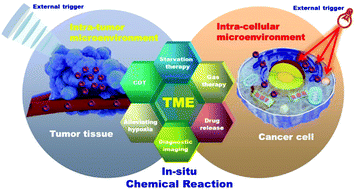当前位置:
X-MOL 学术
›
Chem. Soc. Rev.
›
论文详情
Our official English website, www.x-mol.net, welcomes your
feedback! (Note: you will need to create a separate account there.)
Nanoparticle-triggered in situ catalytic chemical reactions for tumour-specific therapy
Chemical Society Reviews ( IF 40.4 ) Pub Date : 2018-02-08 00:00:00 , DOI: 10.1039/c7cs00471k Han Lin 1, 2, 3, 4, 5 , Yu Chen 1, 2, 3, 4, 5 , Jianlin Shi 1, 2, 3, 4, 5
Chemical Society Reviews ( IF 40.4 ) Pub Date : 2018-02-08 00:00:00 , DOI: 10.1039/c7cs00471k Han Lin 1, 2, 3, 4, 5 , Yu Chen 1, 2, 3, 4, 5 , Jianlin Shi 1, 2, 3, 4, 5
Affiliation

|
Tumour chemotherapy employs highly cytotoxic chemodrugs, which kill both cancer and normal cells by cellular apoptosis or necrosis non-selectively. Catalysing/triggering the specific chemical reactions only inside tumour tissues can generate abundant and special chemicals and products locally to initiate a series of unique biological and pathologic effects, which may enable tumour-specific theranostic effects to combat cancer without bringing about significant side effects on normal tissues. Nevertheless, chemical reaction-initiated selective tumour therapy strongly depends on the advances in chemistry, materials science, nanotechnology and biomedicine. This emerging cross-disciplinary research area is substantially different from conventional cancer-theranostic modalities in clinics. In response to the fast developments in cancer theranostics based on intratumoural catalytic chemical reactions, this tutorial review summarizes the very-recent research progress in the design and synthesis of representative nanoplatforms with intriguing nanostructures, compositions, physiochemical properties and biological behaviours for versatile catalytic chemical reaction-enabled cancer treatments, mainly by either endogenous tumour microenvironment (TME) triggering or exogenous physical irradiation. These unique intratumoural chemical reactions can be used in tumour-starving therapy, chemodynamic therapy, gas therapy, alleviation of tumour hypoxia, TME-responsive diagnostic imaging and stimuli-responsive drug release, and even externally triggered versatile therapeutics. In particular, the challenges and future developments of such a novel type of cancer-theranostic modality are discussed in detail to understand the future developments and prospects in this research area as far as possible. It is highly expected that this kind of unique tumour-specific therapeutics by triggering specific in situ catalytic chemical reactions inside tumours would provide a novel but efficient methodology for benefiting personalized biomedicine in combating cancer.
中文翻译:

纳米触发的原位催化化学反应用于肿瘤特异性治疗
肿瘤化学疗法使用具有高度细胞毒性的化学药物,可通过细胞凋亡或坏死非选择性地杀死癌细胞和正常细胞。仅催化/触发肿瘤组织内部的特定化学反应,才能在局部产生丰富而特殊的化学物质和产物,从而引发一系列独特的生物学和病理学效应,这可能使肿瘤特异性治疗学作用与癌症抗争,而不会给正常人带来明显的副作用。组织。然而,化学反应引发的选择性肿瘤治疗在很大程度上取决于化学,材料科学,纳米技术和生物医学的进展。这个新兴的跨学科研究领域与诊所中常规的癌症-肿瘤治疗方法大不相同。为了响应基于肿瘤内催化化学反应的癌症治疗学的快速发展,本教程综述总结了具有代表性的纳米平台的设计和合成方面的最新研究进展,该平台具有引人入胜的纳米结构,组成,理化性质和生物学行为,可用于多种催化化学反应癌症治疗,主要是通过内源性肿瘤微环境(TME)触发或外源性物理照射。这些独特的肿瘤内化学反应可用于挨饿肿瘤治疗,化学动力疗法,气体疗法,减轻肿瘤缺氧,TME反应性诊断成像和刺激反应性药物释放,甚至是外部触发的多功能疗法。尤其是,我们将详细讨论这种新型癌症-肿瘤治疗方式的挑战和未来发展,以尽可能地了解该研究领域的未来发展和前景。高度期待这种独特的肿瘤特异性疗法通过触发特异性肿瘤内部的原位催化化学反应将提供一种新颖而有效的方法,以有益于个性化生物医学对抗癌症。
更新日期:2018-02-08
中文翻译:

纳米触发的原位催化化学反应用于肿瘤特异性治疗
肿瘤化学疗法使用具有高度细胞毒性的化学药物,可通过细胞凋亡或坏死非选择性地杀死癌细胞和正常细胞。仅催化/触发肿瘤组织内部的特定化学反应,才能在局部产生丰富而特殊的化学物质和产物,从而引发一系列独特的生物学和病理学效应,这可能使肿瘤特异性治疗学作用与癌症抗争,而不会给正常人带来明显的副作用。组织。然而,化学反应引发的选择性肿瘤治疗在很大程度上取决于化学,材料科学,纳米技术和生物医学的进展。这个新兴的跨学科研究领域与诊所中常规的癌症-肿瘤治疗方法大不相同。为了响应基于肿瘤内催化化学反应的癌症治疗学的快速发展,本教程综述总结了具有代表性的纳米平台的设计和合成方面的最新研究进展,该平台具有引人入胜的纳米结构,组成,理化性质和生物学行为,可用于多种催化化学反应癌症治疗,主要是通过内源性肿瘤微环境(TME)触发或外源性物理照射。这些独特的肿瘤内化学反应可用于挨饿肿瘤治疗,化学动力疗法,气体疗法,减轻肿瘤缺氧,TME反应性诊断成像和刺激反应性药物释放,甚至是外部触发的多功能疗法。尤其是,我们将详细讨论这种新型癌症-肿瘤治疗方式的挑战和未来发展,以尽可能地了解该研究领域的未来发展和前景。高度期待这种独特的肿瘤特异性疗法通过触发特异性肿瘤内部的原位催化化学反应将提供一种新颖而有效的方法,以有益于个性化生物医学对抗癌症。











































 京公网安备 11010802027423号
京公网安备 11010802027423号